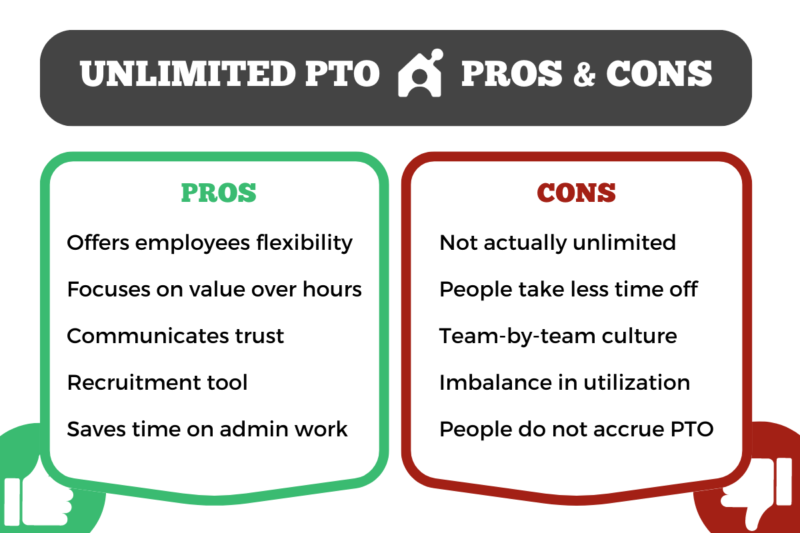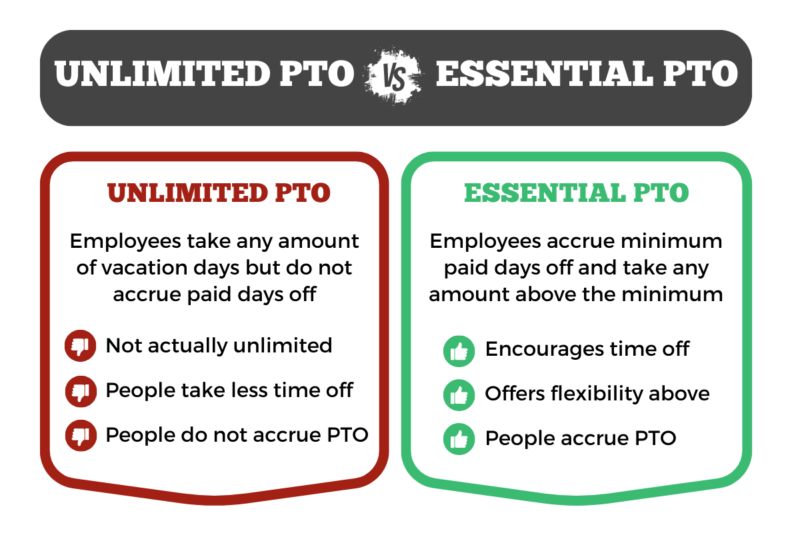Unlimited PTO Is A Trap: Do This Instead

Is unlimited PTO a good thing—or is it possible that unlimited PTO is a trap?
In the post-pandemic battle for talent, many companies offer unlimited PTO (paid time off) as a benefit to attract the best employees. In theory, the policy is attractive because it gives employees flexibility to take off the time they need without worrying about their paycheck. But is that how it works in practice?
For six years, I ran a fully remote company that wanted to offer more flexible and generous PTO to employees. We considered unlimited PTO but were wary. Unlimited PTO has pros and cons, and we determined that on balance, the cons outweigh the pros. Instead we implemented what we called “Essential PTO” to avoid the pitfalls of unlimited PTO.
In this article, I’ll examine the good and the bad aspects of unlimited PTO and make the case for why unlimited PTO is a bad idea. Then, after I’ve convinced you that unlimited PTO is a scam, I’ll offer some ideas for better PTO policies that accomplish what most companies hope to achieve with unlimited PTO—a better work experience for their employees, increased employee engagement and retention, and recruitment advantages—without the downsides.
Unlimited PTO Pros

If my thesis in the introduction sounds counterintuitive, that’s because unlimited PTO sounds great. And if it worked in practice, it would be (more on that in a moment).
For now, let’s focus on the advantages of unlimited PTO that are most often cited. Proponents claim that unlimited PTO:
- Offers employees flexibility to create the work/life balance they need.
- Focuses on the value of the employee’s contributions, not the number of hours worked.
- Communicates trust that employees are the best managers of their work and the time commitment it requires.
- Is useful as a recruitment tool.
- Saves time on HR administration, since use of time off is no longer tracked.
See Also: What Is Unlimited PTO & How Does It Work? | Unlimited PTO Pros & Cons: The Full Analysis | Unlimited PTO Policy Examples & Templates
These advantages have convinced the following well-known companies to adopt unlimited PTO policies:
- Microsoft
- General Electric
- Hubspot
- Netflix
- Oracle
- SoFi
- Sony
- VMWare
- Workday
You can view the entire list of companies with unlimited vacation here.
Unlimited PTO Cons (Why Unlimited PTO Is A Trap)
With all the great benefits unlimited PTO has to offer, there are several reasons why unlimited PTO is a bad idea—for both companies and their employees. My perspective is that unlimited PTO policies are more likely to produce the opposite of the beneficial effects companies hope to achieve. Here’s why:
- Is unlimited PTO really “unlimited”? Of course not. An employee who takes off a year to travel around the world is not going to keep their regular paycheck and job if they’re not doing any work. At best, then, “unlimited” PTO is false advertising – not the best approach when it comes to recruiting employees, because it undermines trust from the very beginning of the employment relationship.
- Evidence shows that people with unlimited PTO take less time off. Employees in companies with unlimited PTO policies tend to take no more PTO than employees in companies with limited/standard PTO policies. In fact, some studies have shown that employees with unlimited PTO take off fewer days.
- Employees tend to follow the lead of their manager or team leader rather than company policy when it comes to the amount of PTO they take. As a result, employees with hard-driving team leaders are likely to take off less time than they would under a limited/standard PTO policy.
- Because access to PTO is influenced more by managers and team leaders than company policy, there can be large imbalances in PTO utilization across a single company. This can create dissension between teams.
- Under unlimited PTO policies, employees do not accrue PTO. As a result, employees who take little PTO are due no compensation when leaving the company for the benefit they didn’t use. Employees who leave companies with limited/standard PTO policies are paid for unused time off when they leave. This is what I refer to as the unlimited PTO scam: it’s a policy dressed up as a benefit for employees, while it’s often delivering a financial benefit to the company and shortchanging workers instead.
These are the reasons why I believe unlimited PTO is a trap—for both employers and employees. In too many cases, it not only fails to meet the goal of providing employees with a better work/life balance—it can also generate resentment between employees and teams as well as a loss of trust when the perk touted at hiring turns out to be, in reality, less paid time off with the loss of compensation for unused PTO to boot.
Over time, these factors may decrease employee engagement and lead to higher attrition—the opposite of what many companies hope to achieve with unlimited PTO policies. Even with the savings a company might accrue due to not paying compensation for unused PTO, it is vastly more expensive to hire and train a new employee. And in my view, by failing to meet the promise implied during recruitment, unlimited PTO policies make it more likely that employees will leave sooner than they would have otherwise.
How To Achieve Unlimited PTO Pros Without The Cons
Now that I’ve made the case for why unlimited PTO is bad policy, I’ll share the policy we created for more flexible PTO—without the downsides of unlimited PTO.
We called it “Essential PTO”
- We turned our former policy (15 days of PTO for full-time employees) into the minimum number of PTO days.
- The minimum PTO accrued just like a normal PTO policy if it was not used.
- Employees could take any amount of PTO desired over the 15-day minimum.
- Having a minimum encouraged employees to take time off.
- If employees chose not to take off the minimum PTO, they were paid for it when leaving the company.
- The policy created the flexibility to take off as much time as wanted or needed beyond the minimum.
Other Unlimited PTO Alternatives
This combination of minimum PTO plus unlimited PTO is something that worked for us to eliminate the downsides of unlimited PTO, but there are other alternatives that meet the goals of helping employees achieve work/life balance while avoiding the disadvantages of unlimited PTO. Here are a few of them:
More PTO days
Maintain a standard PTO policy, but increase the number of days offered.
Floating holidays
Add a number of floating holidays that employees can take off whenever they want on top of your standard PTO.
Flexible time off
Offer non-accrual days that employees can take off over the standard number of PTO days. Functionally, this acts like our “Essential PTO” policy.
4-day work weeks
Consider changing to an alternative work schedule altogether. Hundreds of companies have switched to a four-day work week (including our fully remote company – we implemented a four-day week in 2020) have switched to a four-day, 32-hour work week.
This builds in another PTO day each week.
Unlimited PTO Is A Trap: Try Essential PTO Instead
Whether you choose one of the options above or design your own unique PTO policy, you can avoid the unlimited PTO trap while offering your employees all of the benefits of unlimited PTO.
By determining which type of policy will meet the goals of improving work/life balance without shortchanging employees who choose to take less time off, you’ll be building trust with employees from the beginning, encouraging engagement—and increasing the likelihood that they’ll stay with your company longer.
See Also: Unlimited PTO: The Complete Guide

